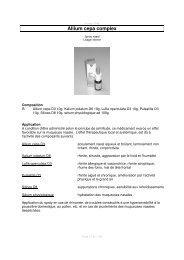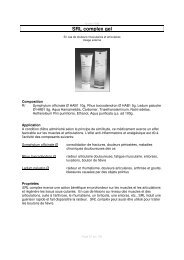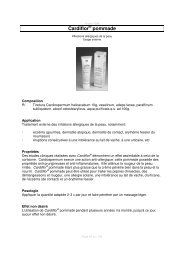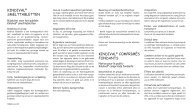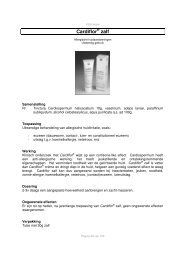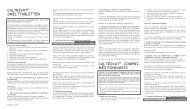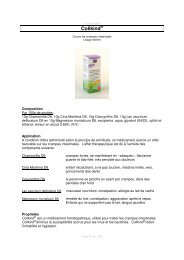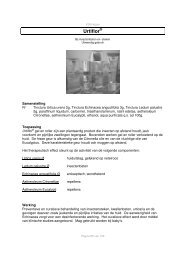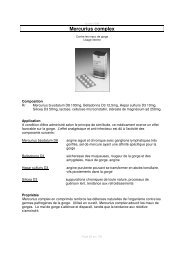Ginkgo special extract EGb 761® in vertigo: A systematic review of ...
Ginkgo special extract EGb 761® in vertigo: A systematic review of ...
Ginkgo special extract EGb 761® in vertigo: A systematic review of ...
You also want an ePaper? Increase the reach of your titles
YUMPU automatically turns print PDFs into web optimized ePapers that Google loves.
Vestibular Compensation<br />
The basis for all the concepts about vestibular compensation is the observation that the unilateral loss<br />
<strong>of</strong> a peripheral vestibular organ <strong>in</strong>itially leads to marked symptoms with severe rotational <strong>vertigo</strong>,<br />
spontaneous nystagmus to the healthy side and ataxia ( 5 ). However, this complex <strong>of</strong> symptoms<br />
becomes less severe and largely disappears after a certa<strong>in</strong> period <strong>of</strong> time, which differs considerably<br />
between <strong>in</strong>dividuals and from species to species. These natural recovery processes may also be<br />
observed <strong>in</strong> animal behaviour experiments and are possibly related to neuronal phenomena which<br />
may be described as an imbalance at the level <strong>of</strong> the vestibular nuclei ( 6 , 7 ). Certa<strong>in</strong> parameters <strong>of</strong><br />
neuronal activity, such as spontaneous activity, and response to dynamic stimuli (such as ga<strong>in</strong> and<br />
phase) show a tendency to reequilibrate. What is <strong>in</strong>terest<strong>in</strong>g is that vestibular compensation may be<br />
improved by additional <strong>in</strong>put from the visual system ( 8 ). These phenomena have been considered to<br />
be the neuronal correlates <strong>of</strong> the vestibular recovery processes.<br />
The recovery from static symptoms, such as <strong>vertigo</strong> at rest, spontaneous nystagmus and ataxia, which<br />
may be completely restored, should be differentiated from the recovery <strong>of</strong> dynamic symptoms, such as<br />
asymmetrical rotation-<strong>in</strong>duced nystagmus reactions and asymmetrical optok<strong>in</strong>etic nystagmus, which is<br />
only <strong>in</strong>complete ( 9 ). What is certa<strong>in</strong> is that vestibular compensation is associated with re-adjustment<br />
processes <strong>in</strong> central nervous structures, primarily <strong>in</strong> the vestibular nucleus ( 10 ).<br />
Possibilities for improv<strong>in</strong>g compensation<br />
When these f<strong>in</strong>d<strong>in</strong>gs are taken <strong>in</strong>to account, the recommendations made <strong>in</strong> the forties for treat<strong>in</strong>g<br />
vestibular diseases by physical therapy appear, retrospectively, to have a rational basis. Cawthorne<br />
and Cooksey's methods ( 11 ) form the basis <strong>of</strong> many tra<strong>in</strong><strong>in</strong>g programmes. These have been<br />
extended or modified many times. In Germany, the s<strong>in</strong>gle-bl<strong>in</strong>d studies <strong>of</strong> Hamann ( 12 ) and later<br />
Strupp et al. ( 13 ) were able to confirm the cl<strong>in</strong>ical success <strong>of</strong> vestibular exercise programmes.<br />
The goal <strong>of</strong> all habituation tra<strong>in</strong><strong>in</strong>g exercises is to more or less specifically stimulate vestibular<br />
performance, but above all to <strong>in</strong>clude auxiliary systems, such as the visual and proprioceptive systems,<br />
<strong>in</strong> the compensation processes. Numerous observations and studies have demonstrated that<br />
vestibular compensation may be <strong>in</strong>fluenced by pharmacological agents ( 2 , 7 ).<br />
Initially, animal experiments were used to <strong>in</strong>vestigate how the compensation processes are <strong>in</strong>fluenced<br />
by pharmaceutical agents. In general, it appears that stimulants such as amphetam<strong>in</strong>e, caffe<strong>in</strong>e or<br />
even strychn<strong>in</strong>e accelerate compensation, while sedatives such as high doses <strong>of</strong> alcohol or<br />
barbiturates slow down the process ( 2 ). Consequently, an ideal compensation-enhanc<strong>in</strong>g substance<br />
should have no sedative properties but should have central stimulatory actions <strong>in</strong> the vestibular nuclei.<br />
Composition and pharmacology <strong>of</strong> <strong>EGb</strong> 761®<br />
<strong>EGb</strong> 761 ® is a <strong>special</strong> <strong>extract</strong> <strong>of</strong> <strong>G<strong>in</strong>kgo</strong> biloba leaves (herbal drug-<strong>extract</strong> ratio 35-67:1)<br />
standardised to 22 - 27 % <strong>G<strong>in</strong>kgo</strong> flavone glycosides and 5 - 7 % terpene lactones (g<strong>in</strong>kgolides,<br />
bilobalide) which conta<strong>in</strong>s less than 5 ppm g<strong>in</strong>kgolic acids. Experimental <strong>in</strong>vestigations have shown<br />
flavone glycosides and terpene lactones to be the most important active <strong>in</strong>gredients ( 14 ).<br />
<strong>EGb</strong> 761 ® has been shown to have neuroprotective effects, <strong>in</strong>clud<strong>in</strong>g improved energy supply by the<br />
mitochondria, antioxidative or radical captur<strong>in</strong>g properties, and to improve cerebral perfusion (through<br />
reduction <strong>in</strong> blood viscosity) and glucose utilisation ( 14 ). The EEG shows that <strong>EGb</strong> 761 ® appears to<br />
have effects that <strong>in</strong>crease vigilance and cognitive activation ( 15 , 16 ). One <strong>of</strong> the ma<strong>in</strong> <strong>in</strong>dications for<br />
<strong>EGb</strong> 761 ® is dementia (Alzheimer's disease and vascular dementia). Which mechanisms play the<br />
decisive role <strong>in</strong> the action <strong>of</strong> <strong>EGb</strong> 761 ® <strong>in</strong> <strong>vertigo</strong> and vestibular compensation cannot be stated<br />
def<strong>in</strong>itively. Depend<strong>in</strong>g on the pathogenetic background, both antioxidative properties and activation <strong>of</strong><br />
cerebral metabolism may be possible as well as vigilance-enhanc<strong>in</strong>g and cognitive activation effects.



